...
![]()
![]() The Characteristics of Korean Dance
The Characteristics of Korean Dance
|
The
characteristics of Korean dance
|
||
Buchae
Dance: Folk Dance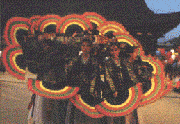 |
In
Korean dance, the dancers use more of their shoulders, arms, hands and heels
with very little leg movement. The most distinguishing
features that pervades many forms of Korean dance are the creation of a
feeling of suspension, particularly of using the feet, the feeling of heaviness
and curvilinear shapes as well as an ongoing quality of energy. The most remarkable characteristic of Korean dance is the impromptu. Also unlike western dance, there is no separation between dancers and the audience. As two crucial key conceptions in Korean dance are Hung(hum) and Mot(Style). When a dancer feels hum, the dancer tends to change the style of dance spontaneously from time to time. The dancer uses the body as a fluid unit raising the body gently and lightly from the bent knee position with arms floating wide. In certain dances such like Salpuli and the monk's dance, these floating garment and fluid movement make the dancer appear to float across the stage. Slight vibrations in suspended position, pulses from the shoulders also make the dancer to convey the deepest sense of ecstatic power. |
|
|
Changgu
Dance :Folk Dance
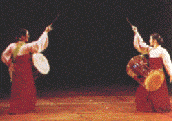 |
The
religious origin of Korean dance Like other Asian culture, Korean dance is deeply associated with three distinct types of religion: Buddhism, Confucianism and Shamanism. The Confucian dancing, where mostly put emphasis on the ceremony, is comprised of dances in honor of Confucius performed twice a year at |
|
|
Royal
Dance Confucius Dance
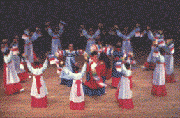 |
Genuine representations of the religious dances of Korea are seen at Buddhist ceremonies, at Chongmyo, the Royal Ancestral Shrine of the Choson Dynasty, and at Munmyo, the Confucian shrine in Songgyungwan(the National Confucian University). Buddhist ceremonies are accompanied by solemn music and dance. The music is called Pomp'ae and the dances chakpop. Chakpop, literally "Creating the Dharma," consists of three parts: Nabich'um (Butterfly Dance), Parach'um (Cymbal Dance), and Popkoch'um (Buddhist Law Drum Dance). These dances offer prayers for the spirits of the deceased and act as a means to guide believers into the Land of Bliss. The music ensemble include chants, a drum, a gong, and a conical wooden oboe. The dances introduced below are offered in the Buddhist ceremonies and Confucian and ancestral rites. |
|
|
Royal
Dance Confucius Dance
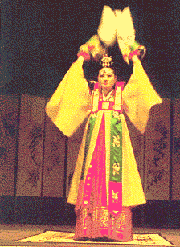 |
Nabich'um (Butterfly Dance) The dancers
are costumed to resemble butterflies. The choreography makes use of about
15 kinds of movements. In front of an altar is hung a huge Buddhist scroll
painting. A pair of monks perform the dance with slow and serene movements
to the accompaniment of a large gong, or hotsori and a chant which lasts
four or five minutes. Parach'um
(Cymbal Dance) Popkoch'um
(Buddhist Law Drum Dance)
|
|
|
Salpuli
Dance :Mixed Dance
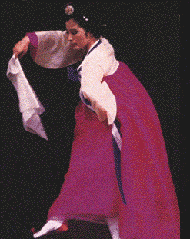 |
Ilmu
(Line Dance) Confucian ceremonial music has its origin in China's Zhou Dynasty. It was introduced into Korea in the 11th year (1116) of King Yejong of the Koryo Dynasty(918-1392). The dance has been offered in the rites honoring Chinese Confucian sages, including Kongzi (Confucius), Mengzi (Mencius), Cengzi, and Yanzi, and Korean Confucian sages including Sol ch'ong and Ch'oe Ch'i-won. The Ilmu dance, performed in the royal ancestral rite held in Chongmyo, is based on the Confucian concepts of courtesy. It is divided into two categories, Munmu (Civil Dance), honoring literary and scholarly achievement, and Mumu (Military Dance) honoring military feats. The Civil Dance is performed with dancers holding a flute in one hand and a dragon-headed stick in the other. The dancers in the front rows of the Military Dance hold swords, while those in the middle rows hold spears; and those in the rear rows hold bows and arrows. The Ilmu dance, offered in the Chongmyo Royal Ancestral Shrine, has preserved its original form intact. It is strictly regulated according to the procedure recorded in detail in Shiyong Mubo (Notations of Korean Dance). The music played in the ancestral rite strictly follows the principle "introduction, development, turn, and conclusion." The Chongmyo Royal Ancestral Shrine was registered on the UNESCO World Cultural Heritage List in December 1995.
|
|
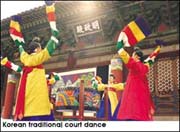 |
Chinese
poet Li Po of the Tang Dynasty wrote the following poem about a Goguryeo
dance: Crowned
in the golden hat, the dancer
|
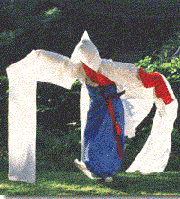 The Monk's Dance: folk / Buddhist Dance |
|
TALCHUM |
other dances: Hwagwanmu (flower crown dance), Ganggangsuweollea (village women's dance), Jindo Buk-chum (Jindo drum dance), Janggo-chum (hourglass-drum dance), Salpuri (exorcist dance) and Buchae-chum (fan dance). |
|